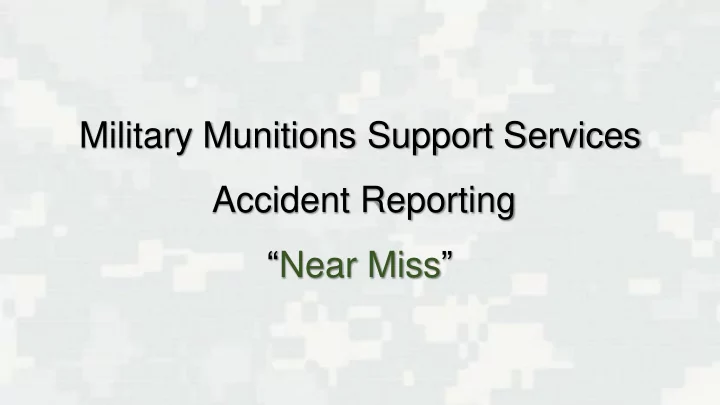

Military Munitions Support Services Accident Reporting “ Near Miss ”
• Near Miss: Osha defines a near miss as an incident in which no property was damaged and no personal injury was sustained, but where, given a slight shift in time or position, damage or injury easily could have occurred . Investigating a high ratio of near misses will find the causal factors and root causes of potential future accidents, resulting in about 95% reduction in actual losses.
BACKGROUND (cont’d) Project: RI/FS in an area surrounding an active open detonation (OD) range. • Field work consisted of site preparation, DGM transects, analog transects, followed by DGM grids, intrusive investigation and soil sampling. • Project team coordinated closely with the installation and operational range for access and control. • Initial field work was only conducted when the range was inactive. • Upon completion of intrusive investigation, soil sampling was scheduled.
INCIDENT • The Project team scheduled two days with the range scheduler and range control for the sampling event. • Upon arrival, the sample team checked in with range control, confirmed that they would be on site for the full two consecutive days, and range control informed the team that no demolition was scheduled and they would have access for both days. • Sample team was issued a range radio and commenced field work. • When departing at the end of the first day at 1715, no one was at range control to check out with. • The team arrived at approximately 0715 on day two, finding no one at range control, they proceeded to conduct sampling.
INCIDENT (cont’d) • At approximately 0915, the team’s range radio started signaling low battery. The team loaded up their supplies to proceed to range control for a new battery. • As they started to depart for range control, a detonation within the OD area occurred. By this time, the radio battery had fully died, so the team quickly drove away from the demo area to a hilltop and called base environmental, during this time, three more detonations occurred. • The base environmental office contacted range control and the team was cleared to return to range control.
INCIDENT (cont’d) • Upon arriving at range control, it was determined that the sample team was give a radio with the incorrect frequency. • The range personnel did not follow their exclusion zone checks, including driving the perimeter roads, the HGL vehicle was parked on the main perimeter road. • Range control did not broadcast and announce demolition operations, the manager did not receive the announcements. • Range control “forgot” that HGL sample personnel were scheduled for sampling and were on the range.
REPORTING • The HGL sample team immediately made local notification to the environmental office POC, who in turn contacted range control. • The Project Manager immediately contacted the Huntsville CEHNC PM and reported within HGL. • HGL Operations Manager, could not reach the OESS, so he reported the incident to the OE Design Center Chief, Ms. Betina Johnson, who then contacted the OESS (not on site). • A Near Miss Report was prepared and submitted. • CEHNC scheduled a meeting with Chief of Safety and the HGL Team. CEHNC and HGL worked closely to establish what happened, why it happened, and the lessons learned .
• Demolition operations were conducted while the range was scheduled for sampling by HGL. WHAT • The range had no formal check in and check out procedure established. AND WHY? • Range personnel did not follow the SOP regarding securing the exclusion zone.
LESSONS LEARNED • Most active ranges have strict access and control procedures; this range has procedures, but they weren’t strictly adhered to by operational range personnel. • Establish and agree to check in and check out procedures at project kickoff and every time we enter a range, even if range control has no set formal procedures. • Ensure that the right communication tools are in hand (radio checks) even if not required by range control. • Verify schedule with range control every day on a range. • HGL has added these requirements to it’s internal readiness review when a project will be in or near an active range.
QUESTIONS? DISCUSSION?
Recommend
More recommend